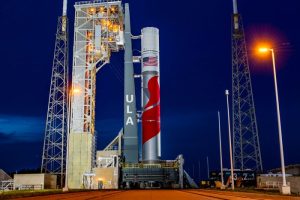The Vulcan Centaur is a new methane-fueled rocket from United Launch Alliance (ULA), one of the U.S.’ most experienced space launch operators. Due to launch in late 2023, the Vulcan Centaur rocket will replace ULA’s well-established workhorses, the Atlas V and the Delta IV, in launching payloads to space.
As with its predecessors, this rocket will launch satellites into a variety of orbits, including geosynchronous ones or missions to the moon, for NASA and other U.S. government customers. However, ULA says the new rocket will be able to fly more cheaply than the company’s older rockets, thanks to an initiative called SMART, which stands for “sensible, modular, autonomous return technology.” This program allows the most expensive parts of the rocket to be recovered after launch and refurbished for reuse. Parts of the new design use well-established technology, such as the Centaur upper stage and the solid rocket boosters used on the Delta IV. More innovative is the main Vulcan core stage, which will employ a completely different type of rocket engine than previous ULA launchers: the BE-4 engine, designed and manufactured by Blue Origin, the spaceflight company started by Amazon founder Jeff Bezos. The BE-4 will also be used for Blue Origin’s New Glenn orbital rocket when it is ready. However, the BE-4 engine has proved to be one of the main stumbling blocks on Vulcan Centaur’s journey to flight readiness, which was originally expected in 2020. The BE-4 is a hugely ambitious piece of engineering, but that’s just one reason for the delays. Ars Technica, reporting from anonymous sources, has also pointed to problems accruing from a shortage of available hardware, necessary design changes and shutdowns in the early stages of the COVID-19 pandemic.

More powerful than the space shuttle’s main engines, the BE-4 is designed to be fueled by methane, which is new in the context of space launch systems. Several companies — including SpaceX, Blue Origin and China’s Landspace — are developing launchers around it, but no methane-fueled rocket has made it to space.
FEATURES
Features Of Vulcan Central Rocket;
1.The Centaur upper stage is 5.4 m (17.7 ft) in diameter and 11.7 m (38.5 ft) long with a 120,000-lb propellant capacity. Its propellant tanks are constructed of pressure-stabilized, corrosion-resistant stainless steel. Centaur is a liquid hydrogen/liquid oxygen-fueled vehicle, with two RL10C engineers. The upper stage, Centaur V, is largely derived from the Atlas V’s upper stage, with its incredibly thin stainless steel tank walls. Thinner than a dime, these tank walls are pressurized to maintain structural rigidity, while dramatically reducing weight, according to ULA.
2. The Vulcan booster has a 5.4 m (18 ft) outer diameter to support the Blue Origin BE-4 engines’ liquid methane fuel. In September 2018, after a competition with the Aerojet Rocketdyne AR1, the BE-4 was selected to power Vulcan’s first stage.
3.Up to six GEM-63XL solid rocket boosters (SRB)s can be attached to the first stage in pairs, providing additional thrust during the first part of the flight and allowing the six-SRB Vulcan Centaur to launch a higher mass payload than the most capable Atlas V 551.
DESIGN
Vulcan is available in four standard offering configurations including zero, two, four and six solid rocket booster (SRB) variants or depending on the configuration.
Height: 202 feet (61.6 m)
Diameter: 18 feet (5.4 m)
Mass: 1.2 million pounds (546,700 kg).
Orbits: Geosynchronous, geosynchronous transfer, low Earth orbit, medium Earth orbit, translunar injection to the moon.

DEVELOPMENT
The Centaur is a family of rocket propelled upper stages produced by U.S. launch service provider United Launch Alliance, with one main active version and one version under development. The 3.05 m (10.0 ft) diameter Common Centaur/Centaur III flies as the upper stage of the Atlas V launch vehicle, and the 5.4 m (18 ft) diameter Centaur V is being developed as the upper stage of ULA’s new Vulcan rocket. Centaur was the first rocket stage to use liquid hydrogen (LH2) and liquid oxygen (LOX) propellants, a high-energy combination that is ideal for upper stages but has significant handling difficulties.
What is the total thrust of this vehicle at lift off.
That changes depending on how much your rocket weighs. If your rocket weighs 5lbs, then you need more than 5lbs of thrust to get it off the ground. This is referred to as the Thrust to Weight Ratio (TWR) of a rocket.
As with any ratio it is a comparison of two values. In this case, those values are the thrust your engines are able to produce and the weight of what you want it to lift
If Thrust Weight, then you can lift off